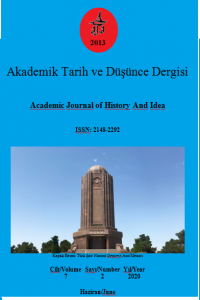Hilafeti Çevreleyen Siyaset (18-19.Yüzyıl)
Hilafet kurumunun özellikle II. Abdülhamid döneminde dinî-siyasi açıdan işlevsel bir konuma geldiği bilinen bir gerçektir. Bu gerçekliğe dayanan anlayış, giderek hilafetin daha önceki tarihsel hüviyetine de taşınmış, bu yapılırken de reel siyasi konjonktürden bağımsız, salt dinî motivasyonla hareket eden bir halifelik algısı popüler hale getirilmiştir. Oysa bu algı, gerçekte zamanın şartlarına göre değişkenlik gösteren hilafet siyasetiyle uyuşmamaktadır. Bu çalışmada hilafetin Osmanlı Devleti açısından tarihsel süreçteki gelişimine değinilmekle beraber esas olarak Hint-Osmanlı-İngiliz ilişkileri bağlamında işlevselliği ele alınmış ve bu kurumun zamanın maddî-siyasi şartları çerçevesiyle kayıtlı/sınırlı bulunan tarihsel bir kurum olduğu ortaya konulmuştur. Tarihsel olarak bu inceleme, 18. yüzyılın başlarından 1857’deki Hint isyanına kadar geçen süredeki gelişmelere odaklanmıştır. Çalışmada yine halife-padişahların salt dinsel motivasyonla hareket etmediği, dönemin ve devletin maddi-siyasi koşullarına göre politika üretmek durumunda oldukları da konuyla ilişkili olarak incelenmiş ve çalışma dönemin literatür kaynaklarına göre ortaya konulmaya çalışılmıştır.
Politics Surrounding the Caliphate (18-19th Century)
It is a known fact that the establishment of the Caliphate became a religious and political functional positions, especially during the reign of Abdulhamid II. The understanding based on this reality has gradually been transferred to the previous historical identity of the Caliphate, and in this process, the perception of a caliphate that is independent of the real political conjuncture and which acts with purely religious motivation has become popular. However, this perception does not actually correspond to the caliphate policy which varies according to the conditions of time. In this study, although the development of the caliphate in the historical process of the Ottoman Empire is mentioned, its functionality is mainly discussed in the context of Indian-Ottoman-British relations and it is revealed that this institution is a bounded / limited historical institution within the framework of material-political conditions of the time. Historically, this study has focused on developments from the early 18th century to the Indian revolt of 1857. In this study it is showed that the caliph-sultans did not act solely with religious motivation; rather they had to produce policies according to the material-political conditions of the period and the state.This also is examined in relation to the subject and the study was tried to put forward according to the literature sources of the period.
___
- CANAN, M. Z., İslam Tarihi: Cahiliyye Devri-Siyer-i Nebi-Halifeler Devri, İstanbul: Yelken Matbaası, 1977.
- DE, S., Marginal Europeans in Colonial India 1860-1920, Kolkata: Thema, 2008.
- HARRİS, J., The Indian Mutiny, Chatham: Wordsworth Editions, 2001.
- HASAN, H. İ., Siyasi-Dini-Kültürel-Sosyal İslam Tarihi: (1-132/622-750): Hz. Peygamber (s.a.s.)’in Hayatı-Hülefa-i Raşidin-Emeviler,çev. İsmail Yiğit-Sadreddin Gümüş, İstanbul: Kayıhan Yayınevi, 1985.
- İNALCIK, H., “Osmanlı Padişahı.” Ankara Üniversitesi SBF Dergisi 13, sy. 4 (01 Nisan 1958):68-79.
- İNALCIK, H., Osmanlı Tarihinde İslamiyet ve Devlet, İstanbul: Türkiye İş Bankası Yayınları, 2016.
- KARAL, E. Z., Osmanlı Tarihi: Nizam-ı Cedit ve Tanzimat Devirleri (1789-1856), Ankara: Türk Tarih Kurumu, 1983.
- KESİR, İbn., Büyük İslam Tarihi: el Bidaye ve’n-Nihaye, çev. Mehmet Keskin, İstanbul: Çağrı Yayınları, 1994.
- KÖKSAL, M. A., İslam Tarihi: Hazreti Muhammed (a.s) ve İslamiyet: Medine Devri, İstanbul: Misvak Neşriyat, 1984.
- KULKE, H.ve ROTHERMUND, D., Hindistan Tarihi, çev. Müfit Günay, Ankara: İmge Kitabevi, 2001.
- MAJUMDAR, R.C., The Sepoy Mutiny and The Revolt of 1857, Calcutta: K. L. Mukhopadhyay, 1957.
- NİZAMİ, K. A., “Hindistan”. Türkiye Diyanet Vakfı İslam Ansiklopedisi, 18: 85-92, İstanbul: TDV Yayınları, 1998.
- Yayın Aralığı: Yılda 6 Sayı
- Başlangıç: 2013
- Yayıncı: Hakan YILMAZ
